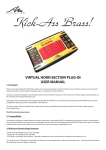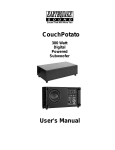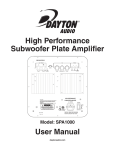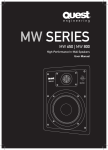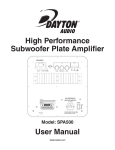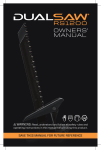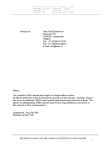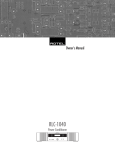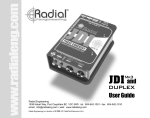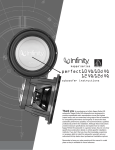Download Dayton Audio RS1200 User Manual
Transcript
Connection/Configurations on either side. Test tones and measurement equipment can help you with your system setup, but good results can also be achieved by spending time with a couple of well recorded CDs with which you are especially familiar. You may find it useful to have an associate make adjustments to the various system controls, or even move speaker enclosures, while you remain in a consistent listening position. After satisfying yourself that your primary location is OK, move around a bit to make sure that the wider soundstage is acceptable. There’s no good reason why a single high quality subwoofer cannot be used for both home stereo and home theatre applications. Each person has his or her own individual preference as far as tonality, loudness, range, or definition is concerned, and the biggest difference between home theatre and home stereo is not the hardware as much as how the hardware is used. A typical home theatre system will tend to have the output of the subwoofer turned up a bit more than what would be appropriate for home stereo. Most cinema soundtracks are mixed with the sub-bass dialed in to create both musical support and dramatic special effects. It is up to you to decide how much you want the Imperial Battle Cruisers to shake your house. Most pre-amps and receivers have a stereo line output that follows the output level that is set by the system master volume control; these outputs would connect to the line-level inputs on the subwoofer amp control panel. Many newer multi-channel receivers have a dedicated mono subwoofer output, usually labeled LFE or Low Frequency Effects. The use of this output will permit you to have separate control over the bass output of the source, and it also permits you to set a crossover frequency. When using an LFE output, use a single cable to connect to the LFE input on the sub amp; keep in mind that this input bypasses the internal low pass filter on the amplifier. For either configuration, the system will operate with the greatest linearity and least noise if all gain controls are balanced; that is, no single gain control is operating at much more than 50% of its total range. If one output is set at 10% and it feeds a corresponding input that ends up at 90% then hum, noise, and overly sensitive control characteristics may result. The RS1200 comes shipped standard for 110V U.S. operation; simply connect the included IEC power cord to your wall outlet. For 220V input, remove the fuse holder, rotate 180 degrees, and re-install. In most 220V applications a separate power cord will be required and is not included. When connecting your subwoofer for the first time, it is important to remember to start with the amplifier OFF and the gain control set at minimum. Start some source program that contains good bass material, apply AC power to the subwoofer, and slowly increase the gain on the sub amp. You should hear a gradual increase in deep bass output as you bring up the volume. When the overall balance between low and high frequency seems close, adjust the phase switch and keep it set where the sub-bass response sounds best in your listening location. You may then use the parametric equalizer to finish off the general contour of the low frequencies, or to correct a troublesome room mode or resonance. These steps to achieve an optimum room response should be used in conjunction with the steps described in the next section, because the physical location of the speaker components in the system can affect performance as much as the electronic adjustments. Troubleshooting Hum: The addition of a new active sub to an existing system can sometimes result in the subwoofer beginning to hum. While it would be easy to assume that the new product is at fault or even defective, it is usually just an indicator that it is time to take a closer look at the overall grounding of the audio system. To start with, verify that all audio equipment in the system is on the same AC power circuit. The outlets in a listening area may or may not all be on the same breaker, some could even be on a completely different breaker panel. Always make sure that all equipment grounds are in good condition, and NEVER remove the ground pin from a power plug. There are some cases where the actual power line has some form of interference but the most common cause of noise is a ground loop, meaning that the system’s different ground points lack a common potential. The cable TV line can be the cause of hum in multi-source home audio/video systems. Just temporarily disconnect the cable line, and if the hum stops then the use of an inline isolation transformer is suggested. Other situations may require the installation of an improved earth ground (connection to a metal water pipe or grounding rod) in the vicinity of the audio/ video system. The key is to proceed slowly and step by step, taking care to identify which cables or combinations of cables cause noise when connected. Room Placement/Integration The requirement for the room location of a subwoofer is substantially different than what we would expect for full range speakers. We are not concerned with stereo imaging due to the omnidirectional nature of sub bass, and bass tends to fill a room with little bearing on positioning the subwoofer in direct line-ofsight. Bass energy is easily reinforced by reflection, and as those reflections recombine, the resulting buildup can cause very irregular response in the room in the form of peaks. Similarly, phase cancellations can occur when the sound waves at a specific frequency cause destructive interference and cancel each other out, and create holes or nulls in the response. Keeping the subwoofer out of the center between two opposing walls, and also out of corners, will help to achieve the most even, consistent response. Some listeners may prefer the “boomier” sound that results from placing a sub in a corner, or need the increase in gain to compensate for some other factor. It is generally a good idea to avoid placing the subwoofer where it is perfectly centered between any two opposing parallel planes (two walls; or the floor and ceiling). In some cases, moving the enclosure just a few feet can make a noticeable difference. 12" Reference Series Subwoofer System Model: RS1200 Weak Bass Output: If bass output seems low, consider the different parts of the system that can contribute to gain or volume. Try moving the subwoofer to a corner. Make sure that the bass output control of the receiver is set correctly (if so equipped). Be sure to use a “Y” cord to connect both line level inputs if you are using a mono source. Verify that the source that is feeding the subwoofer does not have a crossover of its own that is set to a lower frequency than the one in the subwoofer speaker. Specifications Frequency Response: 25Hz-200Hz SPL: 110dB Amplifier Power Output: 500 Watts RMS Signal to Noise Ratio: 98 dB A-weighted Input Impedance: 12K ohms Dimensions: 17”(W) x 17”(H) x 17-1/4”(D) Net Weight: 77 lbs. Power Requirements: 110-120 VAC, 60 Hz. (8A GMA fuse) Aligning the subwoofer along a line drawn between the left/right main speakers will help to keep the speakers in the same time domain and will improve coherence. When properly integrated, the actual location of the subwoofer will disappear and the bass will seem to be coming from the main left/right speakers ©2007 Dayton Audio® (4) User's Manual www.daytonaudio.com Thank You...for purchasing the RS1200 Subwoofer System. It produces accurate and powerful bass, making it perfect for home theater or music listening rooms. The rigidly braced cabinet features a textured matte black finish and is coupled to the floor using our “black chrome” spikes set. The Reference Series driver is precision crafted using only the finest components and features a build quality that rivals the best European drivers. This system is available as a kit or fully assembled. In kit form, it can be assembled in less than 1 hour. The kit is fun and easy to assemble and will provide the bass you’ve been missing in your home theater or sound system. Note: If you purchased the system pre-assembled please skip to the “Features” section. Control Panel Left/Right inputs: RCA style jacks that will accept standard line level inputs from a pre-amp level source. They will accept a stereo signal and internally combine it into mono. Both left and right input jacks should be connected to the source in order to drive the amplifier to full output. The use of a “Y” cord is suggested if a mono source is all that is available. Parts Inventory Your Reference Series RS1200 Subwoofer System should include the following: • 1 Subwoofer cabinet • 1 Reference Series driver • 1 Subwoofer amplifier • 1 Speaker cabinet spike set • Convoluted acoustic foam • Cap head driver mounting screws • Amplifier mounting screws (In amplifier box) • Speaker sealing caulk D. Install Driver To ease assembly, all t-nuts have been installed in the cabinet at the factory. The t-nuts included with the cap head driver mounting screws are extra and can be discarded after assembly. First, place the cabinet on its’ back taking care not to damage the amplifier controls. Pull the speaker wire from the back of the amplifier out through the driver hole. Cut off the connectors and strip back the insulation on the wire. Be careful to leave enough length in the wire to connect the speaker. Connect the wire to the speaker, while observing the proper polarity (red to positive speaker terminal, black to negative speaker terminal). Place speaker sealing caulk over the gasket on the back of the speaker. Place driver in the opening and match the mounting flange holes to the threaded holes in the cabinet. Insert each mounting screw one at a time and turn each by hand to start the screw into the threaded hole in the cabinet. You may need to move the driver from side to side to get each screw started. Do not tighten the screws until all the mounting screws have been started by hand. Be careful not to cross thread the screws! After all mounting screws have been started, tighten the screws in a “star” pattern using a 5/32” hex driver. Install the grill. You are finished with the assembly of the subwoofer system. Installation Tools The Reference Series Subwoofer System can be assembled with the following tools: • Phillips Screwdriver • 5/32” Hex Driver • Wire cutters/strippers • Utility knife Assembly Instructions A. Install spiked feet We recommend that you install the feet first so you can quickly identify the cabinet bottom for proper orientation while installing the amp and driver. To ease assembly, all t-nuts have been installed in the cabinet at the factory. The t-nuts included with the spike feet set are extra and can be discarded after assembly. The pointed tip of the spiked foot unscrews, make sure it is in place and hand tight. Install the threaded rod as far as it will go into the other end of the spiked foot. Next, screw the foot into one of the four holes on the bottom of the cabinet until it is flush and hand tight. Repeat procedure for the other three feet. To ensure an airtight fit, we recommend putting a small amount of RTV sealant on the threads and base of the feet before installing to the cabinet. Features The RS1200 powered subwoofer is fully equipped with features that represent the kind of quality and performance that customers have come to expect from the Dayton Loudspeaker line, like: B. Install amplifier The amplifier features a thick foam gasket that provides an airtight seal so no caulk is needed. Insert amplifier into the back of the cabinet. Be sure to position the amp so that the controls and printing are oriented correctly. Using the supplied Phillips head screws, tighten down the amp in a “star” pattern. • High Xmax Reference Series driver • Patented Class G tracking amplifier for more power and greater efficiency • Low distortion electronic and speaker components • Parametric equalizer for optimum response and maximum integration • Soft clip” circuit eliminates harsh overload conditions and protects drivers • Auto on/off with standby mode • Convenient connections and controls for easy hook-up and system integration • User-adjustable crossover frequency control • Gain control for easy volume adjustment • Industry-leading customer service and technical support C. Install foam Put the foam in the cabinet through the front and form it around the inside of the cabinet. You will have to cut the foam with a utility knife to fit it around the brace. Be sure the flat side of the foam is against the cabinet walls. It’s a good idea to use some spray adhesive to tack the foam to the walls. (2) LFE direct input: RCA jack that will accept a signal from the mono LFE (Low Frequency Effects) output on a pre-amp or receiver that is equipped with a dedicated sub bass output. This input bypasses the amplifier’s own internal low pass filter circuitry, relying instead on the processed output provided by the source equipment. This would be the recommended connection for most home theatre surround sound receivers and pre-amps. We would also suggest the use of the LFE input when an external line level electronic crossover or frequency dividing network is used. Parametric Equalizer The amplifier features a fully parametric equalizer to help you to achieve the best possible subwoofer performance. Professional sound engineers have for many years considered the parametric EQ to be one of the most accurate, versatile, and high fidelity tools for audio enhancement. A greater degree of control can be achieved when using the EQ’s unique ability to vary the frequency to be affected, the amount of boost or cut, and the width or narrowness at the selected frequency. The equalizer can be configured for either broad, gentle tone shaping or precise correction, it’s up to you! Power input: This unit features an IEC grounding type power input connector. The IEC connector allows the user to quickly exchange the power cord if it is damaged, or if a longer cord is desired. The IEC inlet connector also features an integrated fuse holder that contains the AC line fuse. EQ-Frequency: Establishes the specific frequency at which EQ boost or cut may be applied between 18 Hz and 80 Hz. EQ-Bandwidth: Determines how narrow or wide the EQ curve will be within a range of 0.1 to 1.0. If for example a frequency of 60 Hz were selected along with a Q of 0.1, the frequencies to either side of 60 Hz would be less affected. This is a narrow bandwidth that could be useful for “surgically” removing an offending peak without disturbing adjacent frequencies. At the other extreme, a Q of 1 would result in a much broader effect which could be used for smooth overall bass boost or cut, to balance the overall tone character of the sub. Low Pass, Gain: Will match the amplifier’s input sensitivity to the output of the preamp source. If the source output has a variable control, we recommend that the user spend a moment or two determining the best balance between the two controls. When a balance is found between low noise, linear level control, and sufficient level to drive the amp to the required output, the gain knob can be considered to be the “volume control” for the subwoofer system. Low Pass, Frequency: This control is used to establish the highest frequency that the subwoofer will reproduce and has a range between 30 and 200 Hz. If your main speakers have good bass capability, you could set the control to a fairly low value at 40, 60, or even 100 Hz. If the main speakers are smaller or do not have much bass output, set the control higher. Experiment with the amount of “overlap” that you will experience when all speakers are playing in the same range. This can be helpful when integrating the subwoofer with the rest of the system and with the room. EQ-Level: Permits the application of up to 6dB of boost or 14.5dB of cut at the selected frequency and bandwidth. Setting the control at the 0 position effectively removes the EQ from the circuit path. It is good to remember that high levels of boost reduce amplifier headroom; it is the same as turning up the low pass gain control but only at the selected EQ frequencies. It would be helpful to reduce or increase the low pass gain control to balance the amount of cut or boost applied by the EQ. Power LED: When the power switch is moved to the “on” position, the LED will illuminate a bright green, to indicate that the amplifier is fully operational and ready to receive typical music program. As the input signal increases to the onset of clipping the LED will turn from green to a yellow color and finally to red, which indicates that the clip limiting circuitry is activated. If an input signal (3 mV or greater) is not detected for 10 to 15 minutes, the amp will go to “stand by” mode and the LED will change to a dim green. Installation The reasonable size and neutral appearance of the RS1200 will provide the user with tremendous flexibility when the time comes to choose a location for the most satisfactory performance. Please be aware that the powerful woofer motor assembly can emit stray magnetic fields, and these fields can have a detrimental effect on TV and computer screens, and magnetic storage media such as videotapes, audio cassettes, and computer data storage discs like floppies and zips. Try to maintain a safe distance of 2 to 3 feet from any of these items to prevent damage, or the loss of recorded data. The side of the subwoofer that includes the control panel should be kept at least 2 to 4 inches from a wall or other surface, but special care should be taken to avoid close proximity to upholstered surfaces or drapes. Please make sure that the control panel has enough free air space around it so that proper cooling can take place. Refrain from using the system in wet or rainy outdoor locations. Phase: This two-position (NOR = 0° phase and REV = 180° phase) switch helps to compensate for differences in the acoustical and electrical characteristics between the subwoofer and the main system speakers. The relative locations of speakers in the system can cause significant disturbances in speaker interaction due to time delay issues, or the destructive phase interferences that can occur at certain frequencies. The use of this switch in conjunction with altering the location of the subwoofer can have a dramatic effect on system integration. The “NOR” setting would be considered the normal or default setting, but be sure to experiment during system set-up. (3)




